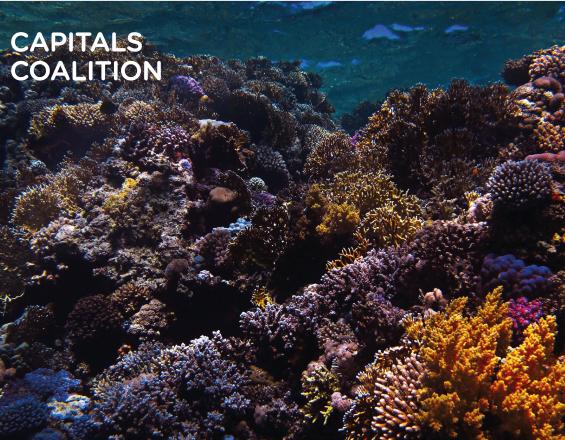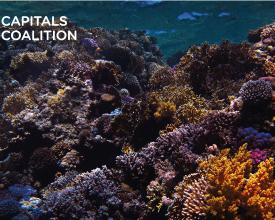
Integrating the value of ocean natural, social and human capital into business decision-making

Businesses play a key role in intelligent ocean management. However, most organizations do not fully understand how their operations or value chains relate to the ocean in terms of how they impact and depend upon it. As a result, businesses do not recognize the value of incorporating the ocean in core business decisions.
The Capitals Approach enables organizations to understand how their success is directly - or indirectly - underpinned by natural capital (renewable and non-renewable natural resources yielding a flow of benefits to people), social capital (networks and shared norms, values and understanding that facilitate cooperation within and among groups) and human capital (knowledge, skills, competencies and attributes of individuals contributing to improved performance and wellbeing).
By identifying, measuring, and valuing impacts and dependencies on ocean capital, a Capitals Approach empowers business to make decisions that offer the greatest value across all capitals.
Context
Challenges addressed
A capitals approach addresses the general lack of understanding of the impact and dependencies ocean-based businesses have on a healthy ocean, and the current limited incorporation of ocean capital values into core business decisions
Location
Process
Summary of the process
The building blocks make up just a few shifts that could be achieved through the inclusion of the capitals into decision-making, thought this approach can be used for many others. The idea of including these real life applications is to demonstrate the tangible contribution that a capitals approach can make to decision-making for government, business and finance
Building Blocks
Better management of ocean biodiversity and ecosystem services
A capitals approach can inform fisheries management supplementing traditional measures such as maximum sustainable yields with more complete metrics
Enabling factors
This is one of the four key shifts proposed for the transition to a sustainable blue economy. Applying a capitals approach to such a case will yield the evidence base needed to inspire action in others
Lesson learned
This work has yet to be completed
More investment into sustainable ocean businesses
A capitals approach can supplement ESG metrics to yield robust information crucial for investor decision making, based on all the capitals, such as the traceability of seafood
Enabling factors
This is one of the four key shifts proposed for the transition to a sustainable blue economy. Applying a capitals approach to such a case will yield the evidence base needed to inspire action in others
Lesson learned
There is a lot of appetite for sustainable investment into blue solutions and a capitals approach can help supplement ESG to make the right investment decisions
Higher contribution from ocean-based businesses to climate targets
By applying valuation to marine spatial planning, a capitals approach can help to value trade-offs when developing offshore energy
Enabling factors
This is one of the four key shifts proposed for the transition to a sustainable blue economy. Applying a capitals approach to such a case will yield the evidence base needed to inspire action in others
Lesson learned
This work has yet to be carried out
Ensuring equity and prosperity for coastal communities
A capitals approach can help compare options between two alternative livelihoods for coastal communities including the impact on people and nature
Enabling factors
This is one of the four key shifts proposed for the transition to a sustainable blue economy. Applying a capitals approach to such a case will yield the evidence base needed to inspire action in others
Lesson learned
This application has yet to be compelte, and will advance the field of social and human capital valuation
Impacts
- Providing robust and actionable information on the value of ocean natural, social and human capital which business can use to make informed decisions for better resource management
- Accelerating the transition to a sustainable blue economy that takes into account the value provided by nature and people
- Enabling ocean-based businesses to recognize the value of a nature-positive and socially just economy, both for the benefit of society and their own business sustainability
- Enabling key shifts such as biodiversity restoration, sustainable ocean finance and climate target setting by gathering robust and actionable data taking into account the whole system
- Highlighting inter-linkages across multiple sectors and along whole value chains, it broadens the understanding of connections and trade-offs between ecosystem services, human livelihoods, social networks, and the flow of monetary and non-monetary resources.
Beneficiaries
- Ocean-based businesses seeking to understand and manage their impacts and dependencies on the ocean
- Society that depends on a healthy ocean for their livelihoods
- Policymakers considering in the role of business in marine spatial planning
Sustainable Development Goals
Story

The capitals approach helps inform operational and strategic decisions across the value chain.
One of the early adopters of the capitals approach was BNP Paribas Asset Management (BNPP AM), a financial institution with a wide and varied portfolio who seeks to reduce the impact of its investments on natural capital.
Today, however, data gaps make measuring impacts and dependencies on natural capital increasingly challenging. BNPP AM is trying to address these gaps through enhanced sector specific Environment, Social, Governance (ESG) analysis of companies to map ‘hot spots’, raise awareness and ultimately incorporate the value of natural capital into investment decisions.
Using the Natural Capital Protocol, BNPP AM carried out a qualitative assessment focusing on two critical issues impacting the sustainability of the ocean 1) seafood sourcing and 2) plastic/packaging strategies. The assessment began by analyzing each company with a set of indicators. They looked at how well a company was setting and achieving their targets, how involved they were with stakeholder engagement, their transparency risk management, biodiversity protection and performance. Based on this qualitative review, they assigned a positive, neutral or negative category for each criteria. A bonus/malus ranging from -30% to +30% which was applied to the company’s ESG score and leading to several changes in ESG recommendations, both upwards (e.g. a company moving from neutral to positive) and downwards (e.g. a company moving from neutral to negative).
BNPP AM’s ESG scores were disseminated to all portfolio managers and are now applied in the following ways:
- For Socially Responsible Investing (SRI) best-in-class funds, portfolio managers cannot invest in the bottom three ESG deciles.
- For non-SRI funds, portfolio managers follow an ‘ESG integration’ approach, where ESG analysis is integrated in various stages of the investment process, with the target for all funds to have more favourable ESG characteristics (e.g., a higher ESG score and lower carbon footprint) than their reference benchmark.
This ranking allowed them to inform clients about which were good investments and which were not. The inclusion of natural capital related value into ESG scores therefore enhanced their decision-making leading to more positive outcomes for the ocean economy.


